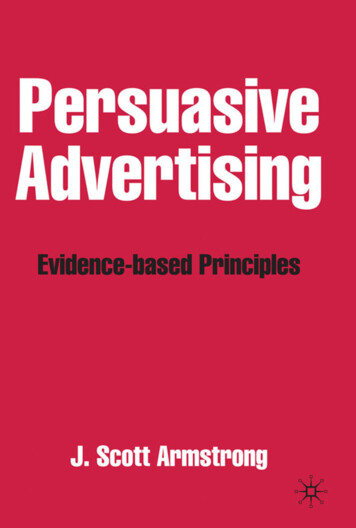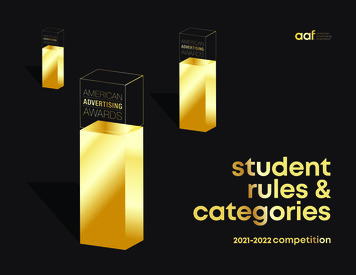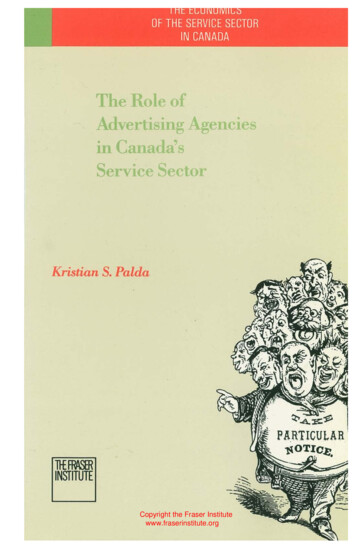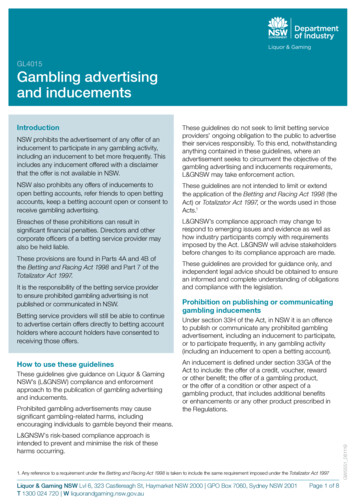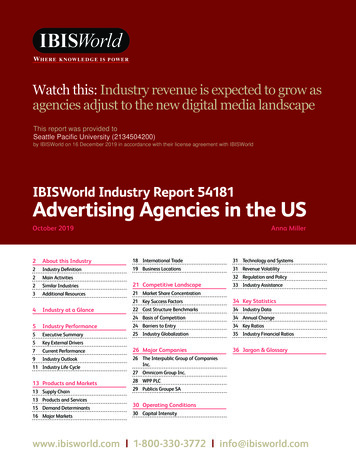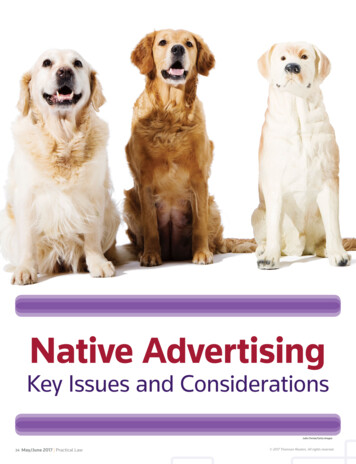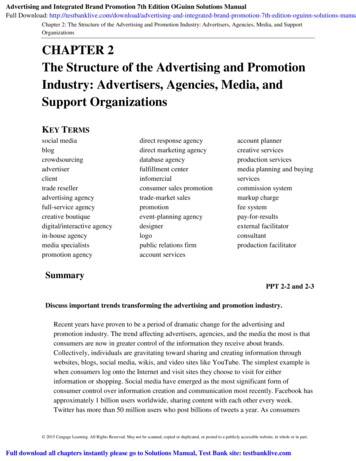
Transcription
Advertising and Integrated Brand Promotion 7th Edition OGuinn Solutions ManualFull Download: ions-manuaChapter 2: The Structure of the Advertising and Promotion Industry: Advertisers, Agencies, Media, and SupportOrganizationsCHAPTER 2The Structure of the Advertising and PromotionIndustry: Advertisers, Agencies, Media, andSupport OrganizationsKEY TERMSsocial mediablogcrowdsourcingadvertiserclienttrade reselleradvertising agencyfull-service agencycreative boutiquedigital/interactive agencyin-house agencymedia specialistspromotion agencydirect response agencydirect marketing agencydatabase agencyfulfillment centerinfomercialconsumer sales promotiontrade-market salespromotionevent-planning agencydesignerlogopublic relations firmaccount servicesaccount plannercreative servicesproduction servicesmedia planning and buyingservicescommission systemmarkup chargefee systempay-for-resultsexternal facilitatorconsultantproduction facilitatorSummaryPPT 2-2 and 2-3Discuss important trends transforming the advertising and promotion industry.Recent years have proven to be a period of dramatic change for the advertising andpromotion industry. The trend affecting advertisers, agencies, and the media the most is thatconsumers are now in greater control of the information they receive about brands.Collectively, individuals are gravitating toward sharing and creating information throughwebsites, blogs, social media, wikis, and video sites like YouTube. The simplest example iswhen consumers log onto the Internet and visit sites they choose to visit for eitherinformation or shopping. Social media have emerged as the most significant form ofconsumer control over information creation and communication most recently. Facebook hasapproximately 1 billion users worldwide, sharing content with each other every week.Twitter has more than 50 million users who post billions of tweets a year. As consumers 2015 Cengage Learning. All Rights Reserved. May not be scanned, copied or duplicated, or posted to a publicly accessible website, in whole or in part.Full download all chapters instantly please go to Solutions Manual, Test Bank site: testbanklive.com
Chapter 2/The Structure of the Advertising and Promotion Industry: Advertisers, Agencies, Media, and SupportOrganizationssearch for more control over their information flow, advertisers, agencies, and mediaorganizations are struggling to adapt to consumer desires.Next, the proliferation of media from cable television to satellite radio to the Internet hascreated new advertising options. Giant media conglomerates are expected to control amajority of these television, radio, and Internet properties. Media proliferation has, in turn,led to increasing media clutter and fragmentation, reducing the effectiveness ofadvertisements. As a result, advertisers are using more IBP tools like sales promotions, eventsponsorships, and public relations to supplement and enhance the primary advertising effort.Crowdsourcing is the next big trend affecting the industry. The idea behind crowdsourcing isto get consumers more involved with and committed to a brand in a way that passive,intrusive advertising simply cannot. Consumers help “build the brand” withrecommendations for features, advertising, or events. They can also communicate about thebrand to audiences in ways that seem natural and credible—something corporate launchedadvertising struggles with. Finally, mobile marketing/mobile media may turn out to be thebiggest trend that affects the industry. Technology has resulted in significant opportunitiesfor advertisers to reach consumers with messages directed to consumers’ mobile devices—primarily smartphones, tables like the Apple iPad, e-readers like the Amazon Kindle;however, personal navigation devices (PNDs) can also accommodate messages in thewireless world.Describe the advertising and promotion industry’s size, structure, and participants.Many different types of organizations make up the industry. To truly appreciate whatadvertising is all about, one must understand who does what and in what order in the creationand delivery of an advertising or IBP campaign. The process begins with an organization thathas a message it wishes to communicate to a target audience. This is the advertiser. Next,advertising and promotion agencies are typically hired to launch and manage a campaign, butother external facilitators are often brought in to perform specialized functions, such asassisting in the production of promotional materials or managing databases for efficientdirect marketing campaigns. New to the industry in recent years are digital/interactiveagencies which specialize in mobile marketing and social media campaigns. Externalfacilitators also include consultants with whom advertisers and their agencies may conferregarding advertising and IBP strategy decisions. All advertising and promotional campaignsmust use some type of media to reach target markets. Advertisers and their agencies musttherefore also work with companies that have media time or space.Discuss the role played by advertising and promotion agencies, the services provided bythese agencies, and how the agencies are compensated. 2015 Cengage Learning. All Rights Reserved. May not be scanned, copied or duplicated, or posted to a publicly accessible website, in whole or in part.
Chapter 2: The Structure of the Advertising and Promotion Industry: Advertisers, Agencies, Media, and SupportOrganizationsAdvertising and promotion agencies come in many varieties and offer diverse services toclients with respect to planning, preparing, and executing advertising and integrated brandpromotion (IBP) campaigns. These services include market research and marketing planning,the actual creation and production of ad materials, the buying of media time or space forplacement of the ads, and traffic management to keep production on schedule. Someadvertising agencies appeal to clients by offering a full array of services under one roof;others such as creative boutiques, develop a particular expertise and win clients with theirspecialized skills. Promotion agencies specialize in one or more of the other forms ofpromotion beyond advertising. New media agencies are proliferating to serve the Internet andother new media needs of advertisers. Compensation schemes in the industry vary. The fourmost prevalent ways to compensate an agency for services rendered are commissions,markups, fee systems, and the new pay-for-results programs.Identify key external facilitators who assist in planning and executing advertising andintegrated brand promotion campaigns.Marketing and advertising research firms assist advertisers and their agencies inunderstanding the market environment. Consultants of all sorts from marketing strategythrough event planning and retail display are another form of an external facilitator. Perhapsthe most widely used facilitators are in the area of production of promotional materials. Inadvertising, a wide range of outside facilitators is used in the production of both broadcastand print advertising. In promotions, designers and planners are called on to assist in thecreation and execution of the promotional mix tools. Software firms fill a new role in thestructure of the industry. These firms provide expertise in tracking and analyzing consumerusage of new media technology.Discuss the role played by media organizations in executing effective advertising andintegrated brand promotion programs campaigns.Media organizations are the essential link in delivering advertising and IBP communicationsto target audiences. There are traditional media organizations such as television, radio,newspaper, and magazines. Interactive media options include not just the Internet andwireless access to consumers through smartphones and iPads, but also through broadbandvideo streaming. Media conglomerates such as AT&T, Time Warner, and News Corp. controlseveral different aspects of the communications system, from cable broadcast to Internetcommunications and emerging high-speed broadband communications technologies.Chapter Outline 2015 Cengage Learning. All Rights Reserved. May not be scanned, copied or duplicated, or posted to a publicly accessible website, in whole or in part.
Chapter 2/The Structure of the Advertising and Promotion Industry: Advertisers, Agencies, Media, and SupportOrganizationsThis chapter contains some key information about the new era for advertising (and its role inintegrated brand promotion, or IBP). While the industry has been characterized by rapid changefor the last two decades—primarily driven by technological change as introduced in Chapter1—the current era of change is highly significant. More than ever before, advertising agenciesare being challenged by both advertisers and consumer. Advertisers are demanding moreeffective communications and measurable results. Consumers now have more alternatives foracquiring information—PDAs, smartphones, the Internet (particularly blogs and social medianetworks), and TiVo devices—and more control over those alternatives. Throughout thischapter and carrying over into Chapter 3, the issue of control will be highlighted. Advertisers’response and the even greater importance of the brand are considered.I. The Advertising Industry in Constant TransitionThere have always been power struggles in the advertising and promotion industry. Now,however, it is about how the advertising industry can successfully adapt to the new technologiesthat consumers are willing and, in many cases, eager to use as they seek more control over theirinformation environment. The solution seems to be that advertisers will continue in the “digitaldivide.” That is, dividing their total advertising spending more into digital media—Webadvertising, social media, and mobile marketing—and continue to move away from traditionalmass media like television, newspapers, magazines, and radio.II. Trends Affecting the Advertising and Promotion IndustryThe following are trends affecting the advertising and promotion industry.PPT 2-4 and 2-5A. Consumer Control: From Social Media to Blogs to DVRsConsumers are now in greater control of the information they receive about productcategories and the brands within those categories. Social media, blogs, and DVRs devices arethree prime examples. Advertisers and their agencies are trying to adapt to the concept thatconsumers are gaining greater control by making more creative ads which will more likely bewatched by the consumers.B. Media Proliferation, Consolidation, and “Multiplatform” Media OrganizationsAt another level of the industry, media proliferation and consolidation are taking placesimultaneously. Media companies of all types tend to pursue more and more “properties” if 2015 Cengage Learning. All Rights Reserved. May not be scanned, copied or duplicated, or posted to a publicly accessible website, in whole or in part.
Chapter 2: The Structure of the Advertising and Promotion Industry: Advertisers, Agencies, Media, and SupportOrganizationsthey are allowed to legally, thus creating what are now referred to as “multiplatform” mediaorganizations. The ultimate multiplatform may be Walt Disney Co., which owns the ABCbroadcasting network and the ESPN cable network group, plus multiple other cable stations.C. Media Clutter and Fragmentation Means More IBPThere are more ways for the advertiser to reach the consumer than ever before. However,given the backlash against advertising that clutter can cause, advertisers and their agenciesare rethinking the way they try to communicate with consumers. There is a greater focus onintegrating more tools within the overall promotional effort in an attempt to reach moreconsumers in more different ways. J&J moved hundreds of millions of dollars away fromtraditional media to digital media including the Internet and blogs.D. CrowdsourcingCrowdsourcing involves the online distribution of certain tasks to groups (crowds) ofexperts, enthusiasts, or even consumers. The idea behind crowdsourcing is to get consumersmore involved with and committed to a brand in a way that passive, intrusive advertisingsimply cannot. Consumers help “build the brand” with recommendations for features or evenadvertising campaign images. They also can communicate about the brand to audiences inways that seem natural and credible. Refer to Ford and Starbucks as prime examples.E. Mobile Marketing/Mobile MediaTechnology has resulted in significant opportunity for advertisers to reach consumers withmessages directed to consumers’ mobile devices—primarily smartphones and tablets. Thechallenge will be to make the messages relevant and acceptable to consumers.III. The Scope and Structure of the Advertising IndustryPPT 2-6Spending is approaching 400 billion annually in the United States with worldwide advertisingexceeding 600 billion. Another perspective on the scope of advertising and promotion is theamount spent on advertising by individual firms—the 3.05 billion spent by General Motors onadvertising was only about 2.6 percent of GM’s sales. Exhibit 2.5 shows the 20 largest investorsin the United States in 2011.A. Structure of the Advertising and Promotion IndustryPPT 2-7 2015 Cengage Learning. All Rights Reserved. May not be scanned, copied or duplicated, or posted to a publicly accessible website, in whole or in part.
Chapter 2/The Structure of the Advertising and Promotion Industry: Advertisers, Agencies, Media, and SupportOrganizationsThe structure of the advertising and promotion industry clarifies who does what, in whatorder, during the process. Exhibit 2.6 shows the structure of the advertising and promotionindustry by showing who the different participants are in the process. It demonstrates thatadvertisers can employ the services of agencies that may (or may not) contract forspecialized services with various external facilitators which results in advertising andpromotion being directed with the help of various media organizations to one or more targetaudiences. It is important to note here that advertisers do not always need to employ theservices of agencies. Nor do advertisers or agencies always seek the services of externalfacilitators. Some advertisers deal directly with media organizations and Internet portals forplacement of their advertisements or implementation of their promotions.B. AdvertisersPPT 2-8 here, 2-9, and 2-10First in the structure of advertising are the advertisers themselves. Advertisers are business,not-for-profit, and government organizations that use advertising and other promotionaltechniques to communicate with target markets and to stimulate awareness and demand fortheir brands. Advertisers are also referred to as clients by their advertising and promotionagency partners. The following categories describe the different types of advertisers and therole advertising plays for them.Manufacturers and Service FirmsLarge national manufacturers of consumer products and services are the most prominentusers of advertising and promotion, spending billions of dollars annually. Procter &Gamble, General Foods, Verizon, and Anheuser-Busch InBev all have national or globalmarkets for their products and services.Students should note here that regional and local producers of household goods andservices also rely heavily on advertising. These firms often use ads placed in newspapersand regional editions of magazines.Trade ResellersThe term trade reseller is simply a general description for all organizations in themarketing channel of distribution that buy products to resell to customers.As text Exhibit 2.6 shows, resellers can be retailers, wholesalers, or distributors. Retailersthat sell in national or global markets are the most visible reseller advertisers and 2015 Cengage Learning. All Rights Reserved. May not be scanned, copied or duplicated, or posted to a publicly accessible website, in whole or in part.
Chapter 2: The Structure of the Advertising and Promotion Industry: Advertisers, Agencies, Media, and SupportOrganizationspromotion users. Walmart, The Gap, and McDonald’s are examples of national and globalretail companies that use various forms of IBP to communicate with customers.Wholesalers and distributors have little need for mass media and use trade publications,directory advertising trade directories, direct mail, personal selling, and their Internetwebsites as their main advertising media.Federal, State, and Local GovernmentAlthough it may seem odd to students to list the government as an advertiser, governmentbodies invest millions of dollars in advertising annually. The U.S. government is one ofthe largest spenders on advertising in the U.S., with expenditures exceeding 1 billion inannually. The most visible government campaigns are U.S. government advertising forthe armed forces recruiting and social issues.Social and Not-for-Profit OrganizationsAdvertising by social and not-for-profit organizations at the national, state, and local levelis common—Red Cross, the Nature Conservancy, and United Way are examples. Thisadvertising is used to raise awareness of the organizations, seek donations, and attempt toshape behavior. Organizations such as these use both the mass media and direct mail topromote their causes and services.C. The Role of the Advertiser in IBPPPT 2-11 and 2-12There is an important role played by the advertiser before the services of an agency areenlisted. Advertisers of all sizes and types, have to be prepared for their interaction with anagency in order for the agency to do its job effectively. That is, it is the advertiser’s role to: Describe the value that the firm’s brand provides to users. Describe the brand’s position in the market relative to competitive brands. Describe the firm’s objectives for the brand in the near term and long term (e.g., brandextensions, international market launches). Identify the target market(s) that are most likely to respond favorable to the brand. Identify and manage the supply chain/distribution system that will most effectivelyreach the target markets. Be committed to using advertising and other promotional tools as part of theorganization’s overall marketing strategy to grow the brand.D. Advertising and Promotion Agencies 2015 Cengage Learning. All Rights Reserved. May not be scanned, copied or duplicated, or posted to a publicly accessible website, in whole or in part.
Chapter 2/The Structure of the Advertising and Promotion Industry: Advertisers, Agencies, Media, and SupportOrganizationsPPT 2-13, 2-14, 2-15, and 16Advertisers have a full complement of agencies that specialize in various aspects ofadvertising and promotion.Advertising AgenciesAdvertising agencies provide expertise to help advertisers prepare advertising programs.An advertising agency is an organization of professionals who provide creative andbusiness services to clients related to planning, preparing, and placing advertisements.Exhibit 2.10 shows shows the world’s 10 largest advertising organizations and theirworldwide gross income. The top U.S.-based agencies had combined worldwide incomeof 33.2 billion in 2011.The types of agency professionals who help advertisers in the planning, preparation, andplacement of advertising and other promotional activities include the following:Account plannersCreative directorsMarketing specialistsSales promotion and event plannersAccount executivesCopywritersMedia buyersDirect marketing specialistsArt directorsRadio and television producersGraphic designersWeb developersLead account plannersResearchersChief executive officers (CEOs)Interactive media plannersChief financial officers (CFOs)ArtistsChief technology officers (CTOs)Social media expertsChief marketing officers (CMO)Public relations specialistsFull-Service AgenciesPPT 2-17 and 2-18A full-service agency includes an array of advertising professionals to meet all thepromotional needs of clients. Often, such an agency will also offer a global reach to theclient.Creative BoutiquesA creative boutique emphasizes creative concept development, copywriting, and artisticservices to its clients. An advertiser can employ this alternative for the strict purpose of 2015 Cengage Learning. All Rights Reserved. May not be scanned, copied or duplicated, or posted to a publicly accessible website, in whole or in part.
Chapter 2: The Structure of the Advertising and Promotion Industry: Advertisers, Agencies, Media, and SupportOrganizationsinfusing greater creativity into the message theme or individual advertisement. Creativeboutiques are idea factories; however, as firms search for IBP programs and make acommitment to IBP campaigns, the creative boutique may be an extra expense and stepthat advertisers simply don’t feel they can afford.Digital/Interactive AgenciesThese agencies help advertisers prepare communications for new media such as theInternet, mobile marketing, and interactive television. Digital/interactive agencies focuson ways to use Web-based solutions for direct marketing and target marketcommunications.In-House AgenciesAn in-house agency is often referred to as the advertising department in a firm and takesresponsibility for the planning and preparation of advertising materials. This option hasthe advantage of greater coordination and control in all phases of the advertising process.Another advantage is that the firm can keep all commissions that an external agencywould have earned.Media specialistsMedia specialists are organizations that specialize in buying media time and space andoffer media strategy consulting to advertising agencies and advertisers. The task ofstrategic coordination of media and promotional efforts has become more complexbecause of the proliferation of media options and extensive use of promotional toolsbeyond advertising.Promotion Agencies focus on promotion efforts that full-service advertising agencies donot specialize in. Promotion agencies handle everything from sampling to eventpromotions. Descriptions of different types of promotional agencies and their servicesfollow.Direct Marketing and Database Agencies (also called direct response agencies)These agencies provide a variety of direct marketing services. Direct marketing agenciesand database agencies maintain and manage large databases of mailing lists as one oftheir services. They design direct marketing campaigns that can use either mail ortelemarketing or direct response campaigns using all forms of media. They help 2015 Cengage Learning. All Rights Reserved. May not be scanned, copied or duplicated, or posted to a publicly accessible website, in whole or in part.
Chapter 2/The Structure of the Advertising and Promotion Industry: Advertisers, Agencies, Media, and SupportOrganizationsadvertisers construct and merge databases of target customers. In many cases, theseagencies maintain fulfillment centers, which ensure that customers receive the productordered through direct mail. In addition, many direct marketing agencies can prepareinfomercials for clients.Sales Promotion AgenciesThese specialists design and then operate contests, sweepstakes, special displays, orcoupon campaigns for advertisers. These agencies specialize in consumer salespromotions or trade sales promotions.Event-Planning AgenciesEvent-planning agencies and organizers are experts in finding locations, securing dates,and putting together a team of people to manage an event. The event-planning agency willalso often take on the task of advertising the event.Design FirmsDesigners help a firm create the visual impression of a firm's advertising materials andalso create logos and other visual representations for the brand. They also design most ofthe material used in supportive communications such as banners, package design,coupons, in-store displays, and brochures.Public Relations FirmsPublic relations firms manage an organization’s relationships with the media, the localcommunity, competitors, industry associations, and government organizations.E. Agency ServicesPPT 2-19, 2-20 and 2-21Although not every full-service agency offers every service, the services that can be found infull-service agencies are discussed in the following sections. Exhibit 2.12 details thecommon structure of a full-service advertising agency that also provides a number of IBPservices.Account Services 2015 Cengage Learning. All Rights Reserved. May not be scanned, copied or duplicated, or posted to a publicly accessible website, in whole or in part.
Chapter 2: The Structure of the Advertising and Promotion Industry: Advertisers, Agencies, Media, and SupportOrganizationsAccount services entail identifying the benefits a brand offers, its target audience, and thebest competitive positioning, and then developing a complete advertising plan. In somecases, an agency can also provide basic marketing and consumer behavior research.Another primary task in account services is to keep the various agency teams—creative,production, and media—on schedule and within budget.Marketing Research ServicesThe research services usually entail agency locating studies that have bearing on a client’sadvertising and explaining these studies to the client. Account planner positions havebeen added in many agencies to coordinate the research effort.Creative and Production ServicesThe creative services group prepare the client’s message that will be delivered throughadvertising, sales promotion, direct marketing, social networks, and mobile marketing.Production services include producers (and sometimes directors) who take creative ideasand turn them advertisements, direct mail pieces, and other IBP materials.Media-Planning and Buying ServicesAdvertising agencies themselves provide media planning and buying services similarto those of the specialized agencies. The central challenge is to determine how a client’smessage can most effectively and efficiently reach the target audience.Administrative ServicesAgencies have personnel departments, accounting and billing departments, and salesstaffs that go out and sell the agency to clients. Most important to clients is the trafficdepartment, which has the responsibility of monitoring projects to be sure that deadlinesare met. Traffic managers make sure the creative group and media services arecoordinated so that deadlines for getting ads into media are met.F. Agency CompensationPPT 2-22The way agencies get paid is somewhat different from the way other professionalorganizations are compensated. The four most prevalent agency compensation methods arecommissions, markup charges, fee systems, and pay-for-results plans. 2015 Cengage Learning. All Rights Reserved. May not be scanned, copied or duplicated, or posted to a publicly accessible website, in whole or in part.
Chapter 2/The Structure of the Advertising and Promotion Industry: Advertisers, Agencies, Media, and SupportOrganizationsCommissionThe commission system is the traditional method of agency compensation and is basedon the amount of money the advertiser spends on media. Under this method, 15 percent ofthe total amount billed by a media organization is retained by the advertising agency ascompensation for all costs in creating advertising for the advertiser. The only variation isthat the rate typically changes to 16 percent for outdoor media. Exhibit 2.15 providesstudents with a simple example of how the commission system works. In the last fiveyears, many agencies have challenged this traditional structure and negotiated differentpercentages for commission.Markup ChargesMarkup charges add a percentage to a variety of services the agency purchases fromoutside suppliers. In many cases, an agency will turn to outside contractors for art,illustration, photography, printing, research, and production. The agency then, inagreement with the client, adds a markup charge to these services. A typical markup onoutside services has been 17.65 percent to 20 percent.Fee SystemA fee system is much like that used by consultants or attorneys, whereby the advertiserand the agency agree on an hourly rate for different services provided.Pay for ResultsMany advertisers and agencies alike have been working on compensation programs calledpay-for-results or incentive-based compensation that base the agency’s fee on theachievement of agreed-on results. In this type of program, the agency’s fee is based on theachievement of agreed upon results.G. External FacilitatorsPPT 2-23, 2-24, 2-25, and 2-16External facilitators are organizations or individuals that provide specialized services toadvertisers and agencies.Marketing and Advertising Research Firms 2015 Cengage Learning. All Rights Reserved. May not be scanned, copied or duplicated, or posted to a publicly accessible website, in whole or in part.
Chapter 2: The Structure of the Advertising and Promotion Industry: Advertisers, Agencies, Media, and SupportOrganizationsResearch firms such as Burke and Simmons can perform original research for advertisersusing focus groups, surveys, or experiments to assist in understanding the potential marketor consumer perceptions of a product or services. Other research firms, such as SRIInternational, routinely collect data (from grocery store scanners, for example) and havethese data available for a fee. There are also firms that specialize in message testing todetermine if consumers find advertising messages appealing and understandableConsultantsA variety of consultants specialize in areas related to the promotional process. Advertisersseek out marketing consultants for assistance in the planning stage regarding market segmentbehaviors and macro-economic and cultural trends. Creative and communications consultantsprovide insight on issues related to message strategy and message themes. Media experts helpan advertiser determine the proper media mix and efficient
III. The Scope and Structure of the Advertising Industry PPT 2-6 Spending is approaching 400 billion annually in the United States with worldwide advertising exceeding 600 billion. Another perspective on the scope of advertising and promotion is the amount spent on advertising by individual firms—the 3.05 billion spent by General Motors on


